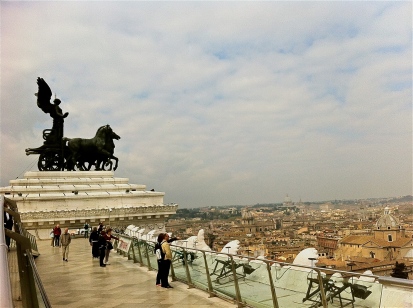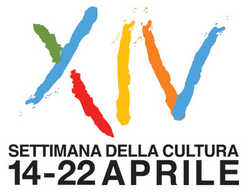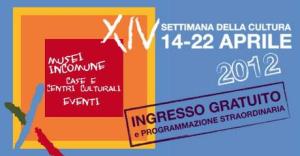Settimana della Cultura: Play the Culture Week Game

Good morning, Rome! Set your alarms early for Saturday April 14th because you’re about to play Culture Week, 8 interactive days of free cultural sites, monuments and museums through out the Italian peninsula and islands. Okay, it’s not really a game, more an incentive by the Ministry of Culture to get people– whether locals or tourists– off the caffe chair and into a museum. However, a few years back, I invented a little healthy competition with some culturally enhanced friends where Culture Week meant we would voraciously visit every museum we’ve ever desired, yet not necessarily had the wallet to finance. At the end of the week, we’d throw down our free entry tickets much as much intensity as Patrick Bateman in the infamous business card scene (at 1:29), and winner literally took all.
 So as not to confuse, Culture Week is primarily for state-run cultural sites and also includes events such as organized concerts and performances. Yes, there is a bit of a groan because the Colosseum/Roman Forum ticket is deliberately excluded from the free entrances this year. However, that double-header ticket seems a reasonable price to pay if everything else is free and Italy is trying to save some pennies culturally. For Lazio and Rome Culture Week info: take a look at this list of free sites/events in the Region of Lazio . In addition, Comune di Roma (City of Rome) organizes events (other local governments do as well). For information about civic museums participating in Culture Week, visit Musei In Comune, and also click here for event listings.
So as not to confuse, Culture Week is primarily for state-run cultural sites and also includes events such as organized concerts and performances. Yes, there is a bit of a groan because the Colosseum/Roman Forum ticket is deliberately excluded from the free entrances this year. However, that double-header ticket seems a reasonable price to pay if everything else is free and Italy is trying to save some pennies culturally. For Lazio and Rome Culture Week info: take a look at this list of free sites/events in the Region of Lazio . In addition, Comune di Roma (City of Rome) organizes events (other local governments do as well). For information about civic museums participating in Culture Week, visit Musei In Comune, and also click here for event listings.
Are you ready to play the Culture Week game? Though the only rule is to get yourself into as many museums as possible, here are some guidelines to racking up as many points as possible:
- Accumulate points by . . . Visiting as many sites as possible and document– photos, instagram, twitter, who cares
- Get Bonus lives by . . . visiting off-beat, unknown and out-of-zone sites like a trip changing visit to Caserta, or listening to a concert at the Casa del Jazz.
- Lose a Life by . . . not paying attention. Some cultural attractions are privately financed and not subject to the free entrances as deigned by the Ministry of Culture.
My plans? Well, life isn’t always about the ancient so expect to find me traipsing about the Museo Napoleonico, enjoying some modern sculpture at the Museo Manzu, investigating Teatro Argentina, or finally figuring out what the Museo Pietro Canonica is all about.
Archaeology, Academics and Social Media

Last week, I woke up to find that AIRC’s twitter account @AIRomanculture has surpassed 500 followers. In an era where celebutantes, actors, sports heroes and gun-toting-fathers rack in thousands a day, 500 followers (in a few months) is merely a blink of the eye. It’s not really even a number. But for us, its a big deal. Why? Aren’t archaeologists, classicists, latinists and any book-toting academics stereotypically nose-deep in text all the time?

Maybe. Maybe not.
Take a glimpse at my archaeo-academic desktop on any morning.
My mornings mean connecting and researching in a world that used to be a bit hard enter into, if you aren’t on campus or at a conference. Reaching 500 followers means we are doing our our job to promote cultural heritage– in other words, getting the word out there, keeping up a continuous dialog and searching out/collaborating with/introducing new people. My world of colleagues and better yet friends has exploded out of Rome and into your computer. I may not know what you look like, but I know what you like and I like what you’re talking about.
Social Media is an incredible and relentless asset for the AIRC. We’ve connected with former students, professors and professionals to find out what they are doing and where they are going, we help in keeping issues current (protecting Greece’s cultural heritage) and we’ve connected with people interested in many of our interests from our academic projects in archaeology, communications and Latin (just take a look at “Latin Tweet Ups”, Pipiatio Latina: aka a lot of people “speaking” Latin on twitter)– to our personal interests such as sustainability in Rome, how Ancient Rome appears in pop culture, gastrotourism, sci-fi literature and art crimes.
So yes, we’ve jumped head first into a kind of contemporary archaeology where history is happening instantaneously. To be honest, I can’t keep up with everything we are “supposed” to be doing or not doing. @Airomanculture has committed the twitter faux pas of following more than our number of followers, but I am pretty sure that we are truly reading everyone we are following– and that their tweets are great. And yes, we do enjoy retweeting information because there are a lot of great people out there on Twitter and Facebook (and I guess Pinterest now) who are sharing great information? Does that make us less personable? I don’t know and I hope not. What I do know is that all of this is good for us, for any academic who may be shy (like me) or not have the time, money, resources, connections, patience to stumble across something new, useful and otherwise mind-blowing. And here’s an update: thanks to Twitter, signatures to stop the proposed landfill next to Villa Adriana,aka Protect Hadrian’s Villa petition, will hopefully surpass 2000 as of March 12, 2012. Sign if you haven’t!
What do you think?
Life in the Trenches: Keep your eyes on the road

 These basalt paving stones have had plenty of centuries to shift out of place. Inattentive walking can be a contact sport in Ostia Antica, and the blocks of volcanic stone and tree roots usually win. Clunk along the old Roman road in your steel-toed boots and breathe in the warm air that smells like fresh-baked bread and wild mint. Take a break from digging to swig some cool water and pick a few blackberries right off the bush.
These basalt paving stones have had plenty of centuries to shift out of place. Inattentive walking can be a contact sport in Ostia Antica, and the blocks of volcanic stone and tree roots usually win. Clunk along the old Roman road in your steel-toed boots and breathe in the warm air that smells like fresh-baked bread and wild mint. Take a break from digging to swig some cool water and pick a few blackberries right off the bush.
Ostia is a wonderful place for field school because you have the entire ancient city to yourself. Duck into a mithraeum or a tomb, read an inscription, ponder an in-situ fresco (and interpret it for yourself), photograph another famous black-and-white mosaic every time you go to work. Getting up early is worth it when you have the pleasure of physical labor and intellectual advancement in an idyllic park outside bustling Rome. This way you get the best of both worlds: all you have to do is shower off the dirt and sunscreen, and you’re ready to enjoy the nightlife and incredible cultural attractions in Rome’s city center.
 Ostia is a surprisingly pastoral ghost town of stone, brick, and concrete with hardy vegetation that both adorns and threatens it. The largest excavation campaign was in preparation for the 1942 World’s Fair, but a large chunk of territory both inside and outside the fence remains to be explored. That which has been exposed could do with further documentation and study, and AIRC is doing its part to strike a sustainable balance betwe
Ostia is a surprisingly pastoral ghost town of stone, brick, and concrete with hardy vegetation that both adorns and threatens it. The largest excavation campaign was in preparation for the 1942 World’s Fair, but a large chunk of territory both inside and outside the fence remains to be explored. That which has been exposed could do with further documentation and study, and AIRC is doing its part to strike a sustainable balance betwe en uncovering the new and rediscovering the old. We are a staff of extremely passionate people who truly want to help you achieve your professional and academic goals, whether or not they lie within the archaeological discipline. We also hope that your experience of studying in a foreign country enriches you as a person. You will find that having to deal with everyday life in Italy can increase your patience and adaptability.
en uncovering the new and rediscovering the old. We are a staff of extremely passionate people who truly want to help you achieve your professional and academic goals, whether or not they lie within the archaeological discipline. We also hope that your experience of studying in a foreign country enriches you as a person. You will find that having to deal with everyday life in Italy can increase your patience and adaptability.
What can you expect to gain from your time at Ostia?
- A solid grounding in good archaeological methodology
- Several lasting friendships
- A grasp of ancient Roman history and Ostia’s place within it
- An excellent farmer’s tan
- The ability to wield a pick axe with panache
- Improved self-reliance and empowerment
What will you love, probably?
- Living in and getting to know Rome, transport strikes and all
- Working in a peaceful, beautiful environment
- Your trench and trenchmates/all other dig people
- Finding awesome stuff
What will you love, probably…not so much?
- Remembering how to fill out context sheets
- Your turn on finds duty (it’s okay, I love them enough for both of us…)
- Getting up early
- Returning to your home country at the end of your odyssey

~Julia Elsey is a three-peat field school participant, AIRC intern and programs assistant, lightning wit and long-distance friend. She scribed the Saverome blog in Spring and Summer 2011, and is tied with Albert Prieto as the best person for a bit of perspective on Life in the Trenches.
Of Snow and Snowmen

 Snowboarding the Circus Maximus? Skiing the via dei Fori Imperiali? Yesterday, the rare snowstorm covered Rome with a beautiful white blanket of fun. Our own Darius Arya set out in search of snow and snowmen. Last time Rome had such a snowfall, everyone had big hair and shoulder pads… February 1985 and 1986.
Snowboarding the Circus Maximus? Skiing the via dei Fori Imperiali? Yesterday, the rare snowstorm covered Rome with a beautiful white blanket of fun. Our own Darius Arya set out in search of snow and snowmen. Last time Rome had such a snowfall, everyone had big hair and shoulder pads… February 1985 and 1986.
To see all of Darius’s adventures in winter wonderland-, follow the link for the full adventures.
Rome at First Sight

My first visit to Rome happened in the middle of my very first visit to Italy, in the summer of 1993, when I was a 21-year-old Classics major. I had come to Italy to get my hands dirty with ancient material culture in an archaeological field school in Tuscany, at a small Etruscan-Roman site located on a hilltop between Florence and Siena. On weekends the project directors took us on day-trips to see important archaeological sites and museums of southern Tuscany and northern Lazio.
One weekend, the project’s assistant director offered to lead an optional weekend trip to Rome. Of course, I jumped at the chance to see, finally, the places I had read so much about during 11 years of studying Latin and the Classics, (more…)
Dig Rome: Palatine Hill

Want to know how we ring in a Happy New Year 2012? We get our hands dirty in history and want you to help! For the first time ever, AIRC is offering a second Summer Archaeological Field School to complement its new project at Ostia Antica. We will be teaming up with Rome’s oldest and most prestigious university La Sapienza to offer the o nce-in-a-lifetime opportunity to dig in one of the most historic spots in the city, the Palatine Hill.
nce-in-a-lifetime opportunity to dig in one of the most historic spots in the city, the Palatine Hill.
Location: NE Corner overlooking the Colosseum, along via Sacra between the arches of Titus and Constantine.
History soundbite: The Palatine is where the Romans thought their city was founded, way back in 753 BC. (more…)











